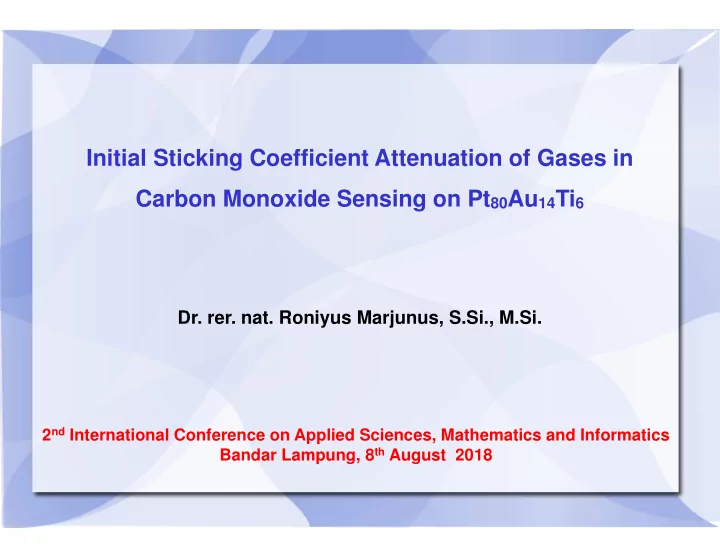

Initial Sticking Coefficient Attenuation of Gases in Carbon Monoxide Sensing on Pt 80 Au 14 Ti 6 Dr. rer. nat. Roniyus Marjunus, S.Si., M.Si. 2 nd International Conference on Applied Sciences, Mathematics and Informatics Bandar Lampung, 8 th August 2018
1. Motivation Carbon Monoxide Gas naturally in atmosphere (< 0.001%) & toxic, colorless, odorless produced by human activities e.g. in fire accident Tolerated Concentration: 30 ppm need sensor Solid State Sensor Resistance Based Sensor Work Function Based Sensor • freedom of sensing material √ √ √ √ X • detect chemisorbed/weakly √ √ √ √ X bound physisorbed at room/high temperatures. • heating is not obligatory √ √ √ √ X • low power consumption √ √ √ √ X 2
2. Introduction Pt 80 Au 14 Ti 6 It was already investigated as CO sensitive layer in normal atmosphere as a work function change based sensor at room temperature. Loss Signal Problem and its Solution The sensitive layer loses its signal after 24 hours in air and can be refreshed by annealing at 170 o C for 10 minutes in air. Attenuation of Initial Sticking Coefficient It is suspected causing the loss signal problem. The Aim of This Research Finding the attenuation factor of initial sticking coefficient of gases. 3
3. Basic Theories Work Function Oxidizing gas Clean Surface Reducing gas E E E E vac E vac E vac E F e E F e E F (Korotchenkov, 2011) where: Φ = E − E Φ F vac : work function (eV) E vac : vacuum energy level (eV) ∆Φ = − new old E E E F : Fermi energy level (eV) F F ∆Φ : work function change (eV) 4
3. Basic Theories, cont. Kelvin Probe Vibrating reference electrode CPD sensitive layer I (Korotchenkov, 2011) 5
3. Basic Theories, cont. Floating Gate Field Effect Transistor (FG-FET) Sensitive Film Hybrid Mounted Top Electrode Guard Ring Air Gap Floating Gate Passivation Oxide Capacitance-well ( n ) Substrate ( p-Si ) Bottom Electrode p -channel MOSFET in the transistor-well ( n ) (Korotchenkov, 2011) 6
3. Basic Theories, cont. Pt 80 Au 14 Ti 6 7
3. Basic Theories, cont. Adsorption, Reaction, Dissociation and Desorption Surface Coverage Change Rate of: 1. Adsorption Process ( ) − Θ 2 − Θ S 1 P E d = 0 a exp σ π dt kT 2 mkT 2. AB as product of A and B Θ − d E = υ Θ Θ AB r exp r A B dt kT 3. A as dissociation of AB − Θ d E = υ Θ diss A exp diss AB dt kT 4. Desorption Process − Θ E d = υ Θ d d exp dt kT 8
3. Basic Theories, cont. Reaction Mechanism Model • Adapting from Water Gas Shift Reaction (WGSR) • State of the art: 18 reactions were filtered from 60 of WGSRs by Callaghan. • This research: Callaghan’s reactions + 2 of WGSRs + 1 new reaction = 21 reactions. • Every reaction: forward and reverse reactions. • One way reaction: reaction energy parameter and Arrhenius coefficient. • Every material: 42 energy parameters and Arrhenius coefficient. Example: 9 coupled differential equations. CPD P − ( ) E = 1 − Θ n F = υ f or r, N r exp x x σ π 2 mkT f or r, N f or r, N kT 9
4. Results and Discussions Attenuation Factor ( f adj1 ) of Initial Sticking Coefficient Reports: (1) Loss Signal Oxygen can diffuse in Pt Problem hex-Pt(100) Pt atom Pt(100)(1x1) (2) O atom (3) f adj1 =1-0.00585exp(5.76664 O sub ) 10
4. Results and Discussions, cont. Simulation with/without Attenuation Factor ( f adj1 ) t (hours) 11
6. Conclusion & Acknowledgement Conclusion 1.The Reaction Mechanism Model is in agreement with the experiment results. 2.Initial Sticking Coefficient should be adjusted with the attenuation factor. 3.Attenuation factor of the Initial Sticking Coefficient is f adj1 =1- 0.00585exp(5.76664 O sub ). Acknowledgement Thank to: 1.Ministerium of Research, Technology and Higher Education, Republic of Indonesia. 2.Universität der Bundeswehr München, Jerman. 12
Thank You for Your Attention Vielen Dank für Ihre Aufmerksamkeit 13
Recommend
More recommend